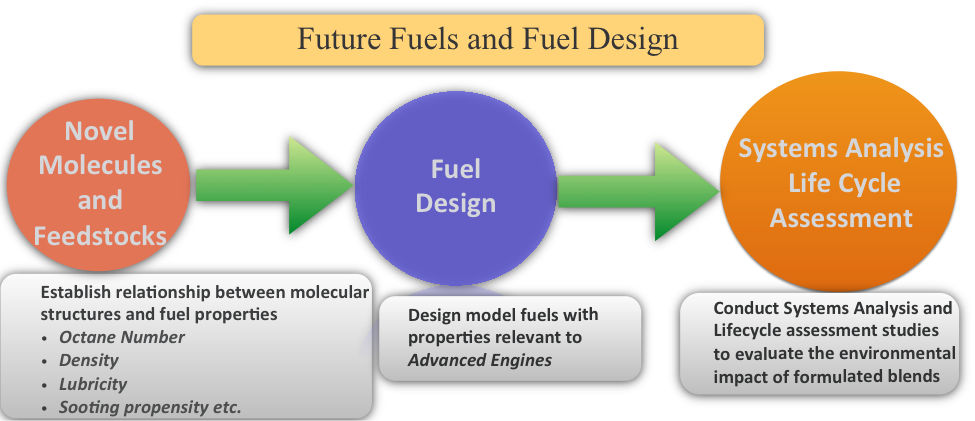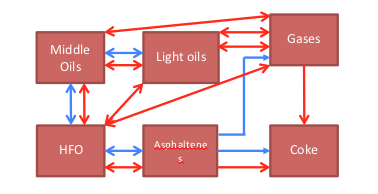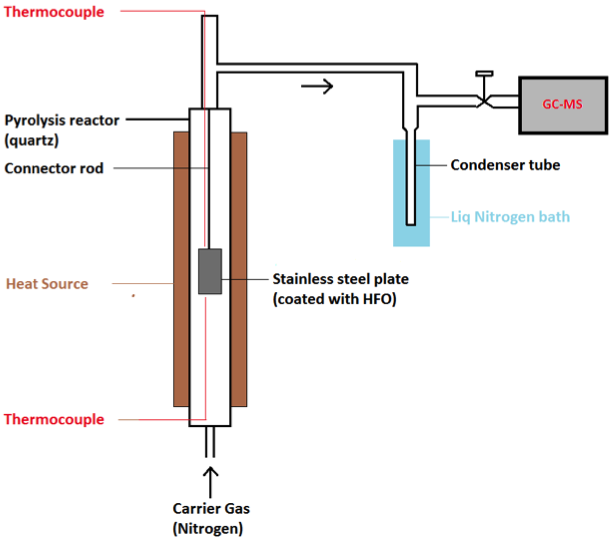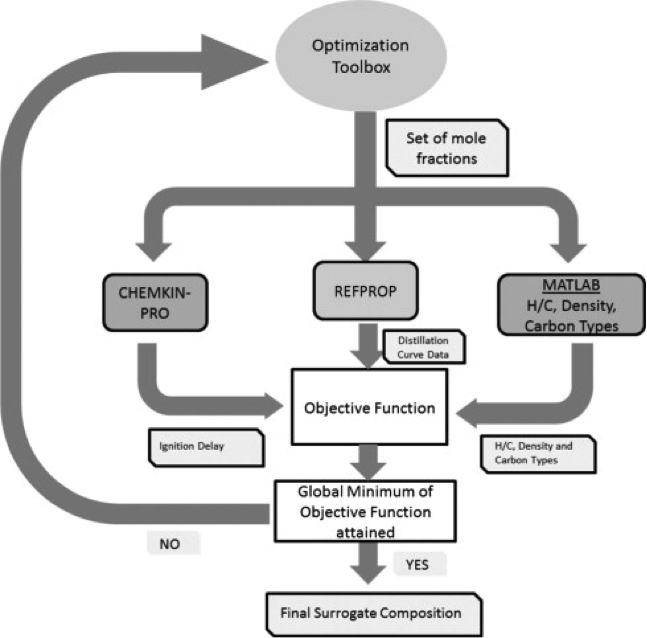
Current Research

The fuel design and future fuels team in the CPC works to develop tailored fuels to power modern and imminent combustion technologies including IC engines (modern and conventional), stationary and aviation turbines, and marine engines.
We employ
a comprehensive approach in our study of fuels. It starts with the identification of novel molecules and fuels, which is followed by fuel design, and then eventually leading to comprehensive system analysis and life cycle assessment. The ongoing studies
within the group are subdivided into 3 major thrust areas namely:
The general worldwide trend in automotive fuels and engine development is directed towards downsizing and turbocharging to attain higher combustion efficiencies and lower emissions. Improved fuel formulations are needed to attain assured engine performance
along with reduced emissions. Some high energetic organic molecules have shown potential as additives to transportation fuels. Some of the molecules currently under study are limonene, dicyclopentadiene, norbornadiene and cubane as shown in Figure
1. WE are also studying a range of bio-derived fuels, including terpineol, pinene, 2-phenylethanol, diethyl eether, ethyl levulinate, and various alcohols.
The utilization of these molecules as fuel additives offers several advantages, namely high internal energy content, consequently, high heat of
combustion, high fuel efficiency, lower CO2 emissions, higher combustion efficiency and
higher flame speeds. The higher energy content of
these molecules ensures greater heat release per unit volume of fuel combusted resulting in lower engine fuel consumption and, therefore,
lower CO2 emissions. Furthermore, the presence of
double bonds in some of these molecules imparts high anti-knock properties hence
allowing higher compression ratios in engines.
 Figure 1: Some of
the novel high energy molecules investigated in the CPC.
Figure 1: Some of
the novel high energy molecules investigated in the CPC.
Another area of interest is to study low grade fuels like heavy fuel oils (HFOs) that are largely used as fuel in power generation and in the
marine industries. One of the major challenges with HFO combustion is that it leads to the release of Sulphur
dioxide emissions and
particulate matter like smoke, cenosphere, and ash that is harmful to the environment. Due to these reasons, the use of HFO has been banned
by bodies like the International Maritime Organization (IMO) in regions closer
to ports.
We are interested in understanding the complex molecular structure of HFO’s and how this information could be used to correlate
combustion characteristics and emissions so that better combustors can be designed. Analytical
techniques like one dimensional 1H and 13C
Nuclear Magnetic Resonance (NMR) spectroscopy and two dimensional Hetero-nuclear multiple bond correlation NMR spectroscopy are being
utilized to understand the molecular structure. Understanding
pyrolysis behavior is also important for combustion kinetic studies. Figure 2
shows various gases evolved along with light and middle oils.

Figure 2: HFO pyrolysis steps. Blue lines from [Baert et al.]. Red lines shows our approach at CPC
Understanding of chemical kinetics allows cleaner combustion of low grade fuels. To develop overall understanding of combustion chemistry of HFO, thin film pyrolysis experiments (Fig. 3.) are designed and it also helps to identify species present in the
gases; light and middle oils using GC-MS and NMR spectroscopy. 
Figure 3. Thin-film pyrolysis reactor: A thin film (20 µm) of HFO helps maintain a uniform temperature on metal plates/glass beads which are then heated in a quartz reactor.
Conventional fuels are designed with properties suited to conventional gasoline and diesel engines. However with continuous evolving combustion strategies for engines and gas turbines, there is an imminent need to design novel fuel blends that are tailored to meet the diverse combustion requirements. The fuel design methodology developed by the CPC group begins with identifying relevant fuel properties and its target range required for a particular combustion mode. To this end, various feedstocks and novel molecules have been identified to formulate fuel blends with properties suited to different modes of combustion like HCCI, DISI etc.. The selection of ingredient molecules and feedstock for preparing a fuel blend is governed by various target fuel parameters. Furthermore a final blend is prepared using various sub-streams and pure species (novel molecules) using multiobjective nonlinear optimization.
The prepared blends are rigorously evaluated utilizing modelling and experimental tools at target conditions to ascertain overall performance and emissions over the entire operating range. Figure 4 shows the adopted approach for fuel design in pictorial format.

COP 21 resulted a global climate deal that aims to reduce greenhouse gas (GHG) emissions to maintain the rise in earth’s temperature below 2. Achieving this target will require major decarbonization of energy supplies by 2050. The shape of future energy systems will be largely influenced by the technical and economic development of energy technologies using fossil fuels, renewables, and nuclear energy. Hence, we perform systems analysis modeling determine the feasibility of alternative fuels and carbon capture and storage (CCS) in achieving 80% reduction in greenhouse emissions, compared with 1990, in Saudi Arabia’s power generation and transportation sectors. The competition between various energy technologies is also analyzed within the constraints of different postulated economic and environmental scenarios. The optimization analysis is conducted using a partial equilibrium energy economic model (MESSAGE) which solves the objective function for the least cost.
The CPC group also performs detailed life cycle analysis (LCA) of alternative fuels blended with conventional gasoline and diesel fuels. Previous work in the literature largely neglects the benefits alternative fuels can provide towards improved engine combustion, so we utilize our combustion expertise to develop models to quantify these effects. Our studies focus on developing optimal fuel blends for downsized turbocharged engines. Refinery processes are modeled using ASPEN to determine process configurations that minimize GHG emissions when the production gasoline/diesel is blended with alternative fuels. Recent results have provided groundbreaking evidence on the best blending strategies for ethanol-gasoline mixtures when used in turbocharged engines.
[1] A. Ahmed, G. Goteng, V.S. Shankar, K. Al-Qurashi, W.L. Roberts, S.M. Sarathy, Fuel, 143 (2015) 290-300.
[2] I.M. Bodas Freitas, E. Dantas, M. Iizuka, (2010).
[3] A.M. Elbaz, A. Gani, N. Hourani, A.-H. Emwas, S.M. Sarathy, W.L. Roberts, Energy
Fuels, 29 (2015) 7825-7835.
[4]
J. Frankenfeld, T. Hastings, M. Lieberman, W. Taylor, (1978).
[5] I. Freitas, E. Dantas, M. Iizuka, (2010).
[6] V. Garaniya, L. Goldsworthy, ANZIAM Journal, 49 (2007) 116-138.
[7] D.R. Kirklin,
K.L. Churney, E.S. Domalski, The Journal of Chemical Thermodynamics, 21 (1989) 1105-1113.
[8] L. Petrakis, D. Allen, NMR for liquid fossil fuels, Elsevier, 2012.

"KAUST shall be a beacon for peace, hope and reconciliation, and shall serve the people of the Kingdom and the world."
King Abdullah bin Abdulaziz Al Saud, 1924 – 2015
Thuwal 23955-6900, Kingdom of Saudi Arabia
© King Abdullah University of Science and Technology. All rights reserved